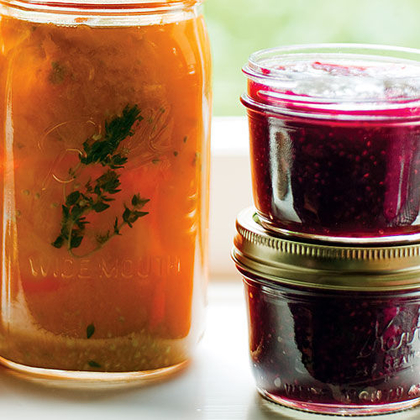Raspberry Blackberry Jam

How to Make It
Follow directions in "Canning ABCs: Get Ready" (below), using 8 regular or widemouthed half-pint jars or 4 pint jars, plus matching rings and lids.
Meanwhile, purée blackberries in a food processor. Rub through a fine strainer over a bowl to extract as much juice as you can. Discard seeds and scrape juice into an 8- to 10-qt. pot. Add raspberries and mash very coarsely with a potato masher.
Measure 4 3/4 cups sugar into a bowl; set aside. Put remaining 1/4 cup sugar in another bowl and stir in pectin. Stir pectin mixture into pot with berries and add butter if you like.
Over high heat, bring berry mixture to a full boil that you can't stir down, stirring constantly with a long-handled spoon and protecting hands from spatters. Add reserved sugar and return to a full boil, continuing to stir. Boil, stirring, exactly 1 minute.
Fill jars: Follow directions in "Canning ABCs: Fill and Seal Jars," leaving 1/4 in. headspace. Wipe rims and seal with lids and rings as directed.
Process as directed in "Canning ABCs: Process Jars," boiling for 5 minutes (boil for 10 minutes at altitudes of 1,001 to 6,000 ft., 15 minutes above 6,000 ft.). If your canning rack won't hold all the jars at once, process them in two batches. Cool, check the seals, and store as directed (up to 1 year).
*Don't use regular Sure-Jell for this recipe. Butter keeps foam from forming during cooking. If you leave it out, skim off foam before ladling jam into jars.
FIRST-TIME TIP: Add sugar to the boiling berry mixture (step 4) all at once; this helps the mixture gel properly.
Canning ABCs:
GET READY:
Gather equipment: canning jars with matching metal lids and rings, a boiling-water canner with rack, a widemouthed funnel, tongs, and a jar lifter. Most hardware stores carry these basics.
Fill canner with water and heat it up. The canner should be two-thirds full for pint and half-pint jars; half-full for quart jars. Set rack on pan rim and cover pan. Over high heat, bring water to a boil (180° to 185° for pickles); this takes 30 to 45 minutes.
Meanwhile, wash canning jars and rings in a dishwasher and hand-wash lids; drain. For jam only, sterilize the washed jars too: When water in canner boils, place jars on rack, lower into water, and boil for 10 minutes. Reduce heat to a simmer and keep jars in water until needed.
Nest lids inside rings in a saucepan and cover with water. Heat until small bubbles form (do not boil). Remove pan from heat and cover.
Rinse produce, then prepare as recipe directs.
FILL AND SEAL JARS:
Ladle foods into jars through a wide funnel or arrange with fingers, leaving the headspace (the distance between jar rim and food) specified by the recipe. If the last jar isn't completely full, let cool, then serve or chill; do not process.
Release air bubbles in chunky mixtures: Gently run a knife around inside of jars. Wipe jar rims and threads with a clean, damp cloth so that lids will seal.
Center lids on jars so the sealing compound on lids touches jar rims. Screw metal rings on firmly, but don't force.
PROCESS JARS:
Lower jars on rack into water. The water should cover jars by at least 1 in.; add hot water as needed during processing. Cover canner and return water to a boil. Cook for time specified in recipe.
Lift rack with jars onto edge of canner, using tongs and a hot pad. Using jar lifter, transfer jars to towels on a work surface. Don't tighten rings. Cool completely at room temperature. You may hear a "ping" as jars form a seal.
Press on the center of each lid. If it stays down, the jar is sealed. If it pops up, it isn't (you can still eat the food—chill it as if it were leftovers). Label jars and store in a cool, dark place up to 1 year.
Note: Nutritional analysis is per 1-tbsp. serving.
Ingredients
Directions
Follow directions in "Canning ABCs: Get Ready" (below), using 8 regular or widemouthed half-pint jars or 4 pint jars, plus matching rings and lids.
Meanwhile, purée blackberries in a food processor. Rub through a fine strainer over a bowl to extract as much juice as you can. Discard seeds and scrape juice into an 8- to 10-qt. pot. Add raspberries and mash very coarsely with a potato masher.
Measure 4 3/4 cups sugar into a bowl; set aside. Put remaining 1/4 cup sugar in another bowl and stir in pectin. Stir pectin mixture into pot with berries and add butter if you like.
Over high heat, bring berry mixture to a full boil that you can't stir down, stirring constantly with a long-handled spoon and protecting hands from spatters. Add reserved sugar and return to a full boil, continuing to stir. Boil, stirring, exactly 1 minute.
Fill jars: Follow directions in "Canning ABCs: Fill and Seal Jars," leaving 1/4 in. headspace. Wipe rims and seal with lids and rings as directed.
Process as directed in "Canning ABCs: Process Jars," boiling for 5 minutes (boil for 10 minutes at altitudes of 1,001 to 6,000 ft., 15 minutes above 6,000 ft.). If your canning rack won't hold all the jars at once, process them in two batches. Cool, check the seals, and store as directed (up to 1 year).
*Don't use regular Sure-Jell for this recipe. Butter keeps foam from forming during cooking. If you leave it out, skim off foam before ladling jam into jars.
FIRST-TIME TIP: Add sugar to the boiling berry mixture (step 4) all at once; this helps the mixture gel properly.
Canning ABCs:
GET READY:
Gather equipment: canning jars with matching metal lids and rings, a boiling-water canner with rack, a widemouthed funnel, tongs, and a jar lifter. Most hardware stores carry these basics.
Fill canner with water and heat it up. The canner should be two-thirds full for pint and half-pint jars; half-full for quart jars. Set rack on pan rim and cover pan. Over high heat, bring water to a boil (180° to 185° for pickles); this takes 30 to 45 minutes.
Meanwhile, wash canning jars and rings in a dishwasher and hand-wash lids; drain. For jam only, sterilize the washed jars too: When water in canner boils, place jars on rack, lower into water, and boil for 10 minutes. Reduce heat to a simmer and keep jars in water until needed.
Nest lids inside rings in a saucepan and cover with water. Heat until small bubbles form (do not boil). Remove pan from heat and cover.
Rinse produce, then prepare as recipe directs.
FILL AND SEAL JARS:
Ladle foods into jars through a wide funnel or arrange with fingers, leaving the headspace (the distance between jar rim and food) specified by the recipe. If the last jar isn't completely full, let cool, then serve or chill; do not process.
Release air bubbles in chunky mixtures: Gently run a knife around inside of jars. Wipe jar rims and threads with a clean, damp cloth so that lids will seal.
Center lids on jars so the sealing compound on lids touches jar rims. Screw metal rings on firmly, but don't force.
PROCESS JARS:
Lower jars on rack into water. The water should cover jars by at least 1 in.; add hot water as needed during processing. Cover canner and return water to a boil. Cook for time specified in recipe.
Lift rack with jars onto edge of canner, using tongs and a hot pad. Using jar lifter, transfer jars to towels on a work surface. Don't tighten rings. Cool completely at room temperature. You may hear a "ping" as jars form a seal.
Press on the center of each lid. If it stays down, the jar is sealed. If it pops up, it isn't (you can still eat the food—chill it as if it were leftovers). Label jars and store in a cool, dark place up to 1 year.
Note: Nutritional analysis is per 1-tbsp. serving.

